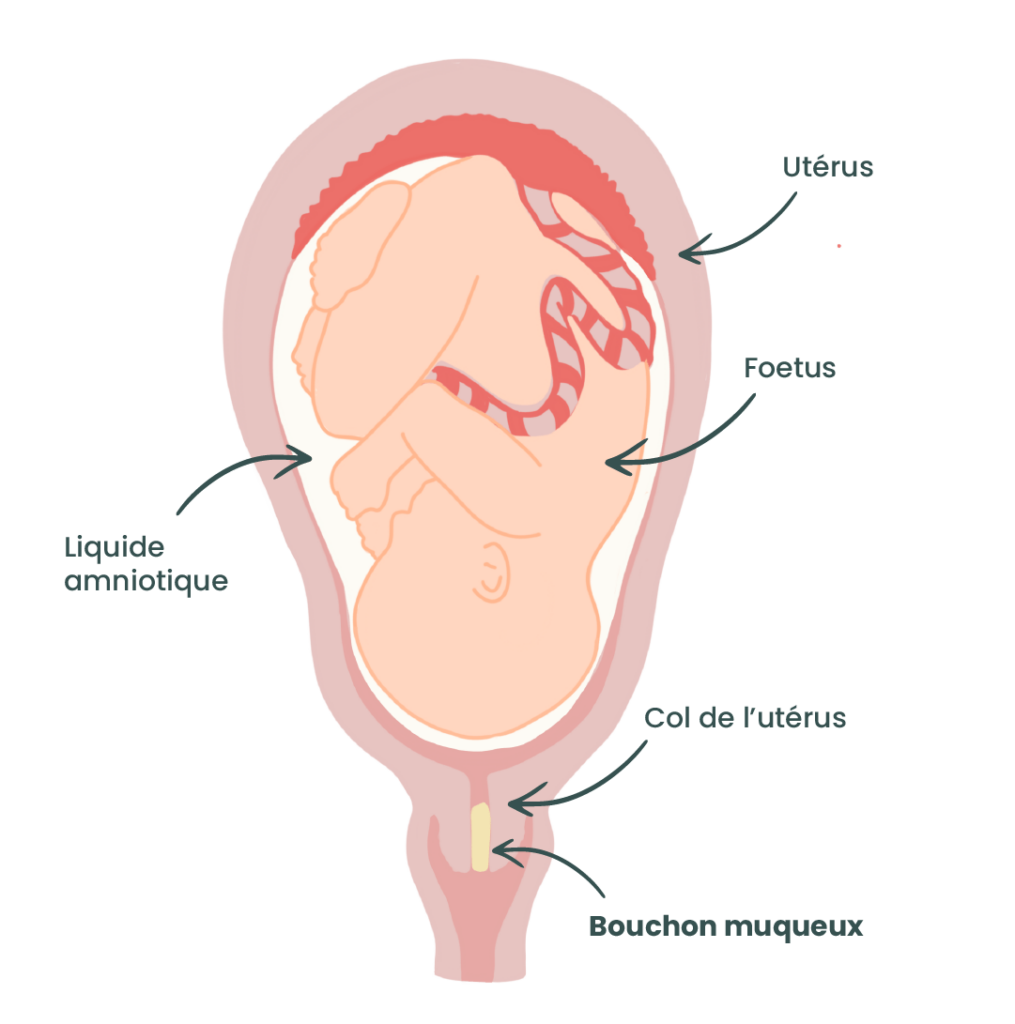
You are in late pregnancy? You’ve probably heard about the famous mucus plug. But is losing it a sign that labor is starting for expectant mothers?
Let’s take a closer look!
What is the mucus plug and how does it form during pregnancy?
Starting from the 4th week of pregnancy, cervical mucus begins to thicken at the level of the cervix and forms the “mucus plug.” This mass of mucus continues to thicken throughout the pregnancy under the influence of hormones. The mucus plug protects the fetus by preventing bacteria and external aggressions from passing through the vagina. It also shields the membranes from mechanical movements.

The size of the mucus plug varies from one pregnant woman to another but tends to be larger during a second pregnancy. On average, it measures about 2.5 centimeters thick, equivalent to two tablespoons of mucus.
What does the mucus plug look like?
The appearance of the mucus plug is thick, jelly-like, with a beige, pink, or brownish color. Unlike urine leaks, it has no odor. These vaginal secretions may also contain blood when your cervix is a bit sensitive.
Want to learn more? Feel free to download the May app, where you’ll find plenty of resources to support and guide you throughout your pregnancy.
Why do you lose the mucus plug at the end of pregnancy?
During regular Braxton Hicks contractions, the dilation of the cervix begins, and the plug is expelled.
The loss of the mucus plug can happen all at once or gradually but tends to go unnoticed. During a first pregnancy, the cervix is less elastic. With each subsequent pregnancy, the mucus plug often becomes easier to identify.
How much time passes between losing the mucus plug and labor?
Losing the mucus plug can occur at any time during the third trimester of pregnancy. Some women lose it a few days before their baby’s birth (or even a few weeks earlier), while others lose it just hours before or during labor.
There’s no need to worry when you lose the mucus plug; it simply indicates that it’s the start of the cervix’s preparation. Losing your mucus plug means labor will likely begin soon. As long as it’s not accompanied by other imminent labor symptoms (such as painful labor contractions every 5 minutes for at least 2 hours and water breaking), there’s no need to go to the hospital. If you are concerned, you can consult your gynecologist or midwife.
❗ Only the rupture of the amniotic sac combined with contractions is a sign of true labor onset for the expectant mother. It is characterized by a clear outflow of amniotic fluid or by leakage. In the event of water breaking, you should go to the hospital as soon as possible because the baby is no longer in a sterile environment. It is not always easy to differentiate between the loss of the mucus plug and amniotic fluid leakage. Amniotic fluid is clear and watery, just like water! In terms of frequency, even if it’s not always continuous, the outflow cannot be held back and will not stop until the baby is born. If you have any doubts, go to the maternity emergency room.
How do you know if you’ve lost the mucus plug?
To know if you’ve lost the mucus plug, watch for certain signs. You might notice a thick, jelly-like substance, tinged with blood or mucus in your underwear, or on toilet paper when you wipe. However, this loss can happen gradually or go unnoticed. If you have any doubts or concerns, don’t hesitate to contact your doctor for personalized advice.
What should you do if you lose the mucus plug?
- Don’t panic: losing the mucus plug is often a normal sign of progress toward labor, but as mentioned earlier, it doesn’t mean labor will start immediately.
- Inform your healthcare professional: contact your healthcare provider to let them know you’ve lost the mucus plug. Remember that every pregnancy is unique, and your healthcare professional will be best positioned to give you specific advice based on your situation.
- Watch for other signs of labor: stay alert for signs that labor is starting, such as regular contractions or water breaking.
Losing the mucus plug does not require alarm or rushing to the hospital. However, it’s strongly recommended to consult your healthcare provider if you lose it long before your due date.
This text was translated from French by an artificial intelligence. The information, advice, and sources it contains comply with French standards and may therefore not apply to your situation. Make sure to complement this reading by visiting the May ES/UK app and consulting the healthcare professionals who are supporting you.


